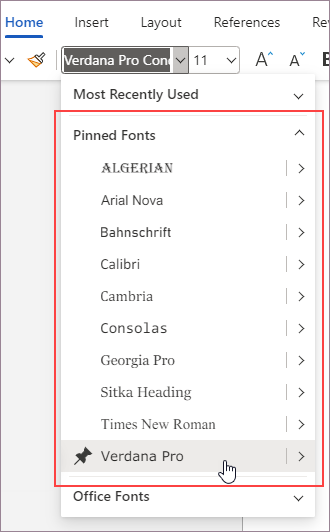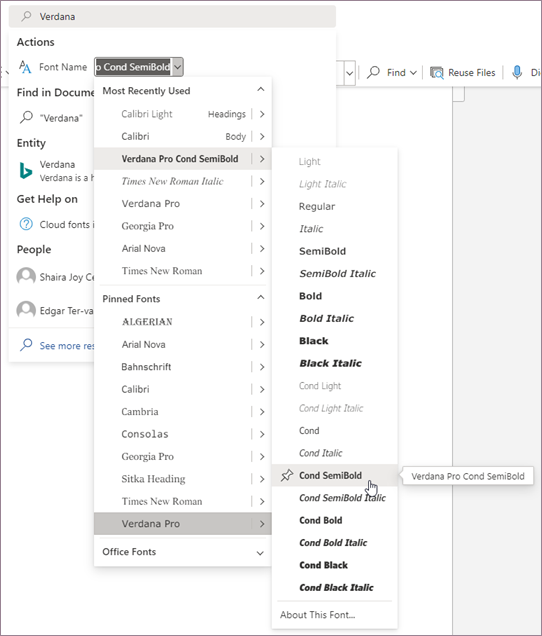The fonts you use are a unique expression of yourself, but it might be a problem to locate a font when you have hundreds to choose from. The modern font picker for Office makes it easier and faster to find just the right font that perfectly suits your document.
Note: Modern font picker is currently available only in Word for the web and PowerPoint for the web. Many of the features of modern font picker are available only with an Microsoft 365 subscription.
About the modern font picker
Until now, when you picked a font in an Office app, you might be confronted with a very long list of options. This is because until now the font picker in Office apps has remained essentially unchanged since its release. Back then, most fonts had no more than four basic variants: regular, bold, italic, and bold italic. Now, there are fonts that have many more variants. Listing each variant as a selectable option often requires a lot of scrolling to get to what you want.
All the features from before modern font picker are carried forward and several new features have been added. Most of the new features are equally available to free users and Microsoft 365 subscribers. The following table shows a comparison between the features available to free users and to users with a Microsoft 365 subscription.
|
Modern font picker features (* indicates new feature) |
M365 subscriber |
Free user |
|---|---|---|
|
Show current font name |
Yes |
Yes |
|
WYSIWYG font names in list |
Yes |
Yes |
|
Cloud fonts support |
Yes |
Yes |
|
Fonts accessible |
900 fonts/260 font families |
82 fonts |
|
Most Recently Used fonts section |
Yes |
Yes |
|
Show all font styles including bold/italic |
Yes |
Yes |
|
*Separate Office fonts section |
Yes |
Yes |
|
*Ability to collapse sections |
Yes |
Yes |
|
*Grouping fonts into families |
Yes |
Yes |
|
*Support Font information pane |
Yes |
Yes |
|
*Improved search |
Yes |
Yes |
|
*Access to premium fonts |
Yes |
No |
|
*Pin fonts |
Yes |
No |
|
*Pinned fonts available on all devices/platforms |
Yes |
No |
|
*Pre-populating pinned fonts |
Yes |
No |
|
*Show information icon for theme fonts |
Yes |
Yes |
|
*Show warning icon for missing fonts |
Yes |
No |
|
*Information icon for embedded/compatibility fonts |
Yes |
No |
Features overview
The following are some feature details showing the advantages of modern font picker.
Organized fonts
As a Microsoft 365 subscriber, you'll see your fonts grouped into families with all the styles for that family accessed through a flyout menu.
You'll see different sections for Most Recently Used, Pinned Fonts, and Office Fonts that you can easily hide when they're not needed.
True bold and italic
Previously, when you applied bold or italic styles from the ribbon, Office applications applied synthetic versions of those styles when no true bold, italic, or bold italic version of the font was available, but you had no way to tell if a synthetic version was applied.
With modern font picker, you'll now see when a synthetic style has been applied. For example, the font Abadi doesn't have an italic version available. If you apply italic from the ribbon, you'll see the name Abadi (italic) in the font picker combo box. The parentheses indicate that italic style has been applied from the ribbon and Office has used a synthetic style because no true style is available.
Where a font has the true bold or italic style, such as Calibri, you see the font name without the parentheses when you apply the bold or italic style from the ribbon, although you could also select the style from the font picker. True styles will always render the same on all devices, but synthetic styles may render differently on different devices.
Localized font names
If Chinese, Japanese, or Korean is your primary browser language, you'll see localized fonts names for fonts that support Chinese, Japanese, or Korean names. For example, if your browser use Japanese as its primary language, you'll see MS 明朝 listed in modern font picker rather than MS Mincho. Likewise, if Korean is your primary language, you'll see 바탕 rather than Batang.
Most recently used fonts
The Most Recently Used section lists the 10 most recently used fonts in reverse chronological order (last to first), except that theme fonts are always at the top.
When you open an existing document, modern font picker lists all the fonts in the document in the Most Recently Used section. This section is dynamic, so as you use different fonts, the list and the order of the fonts in the list will change accordingly.
Pinned fonts
Pinned fonts appear near the top of the font list and grouped together in the Pinned Fonts section for faster access to your frequently-used fonts. You can pin whole families or individual styles. Several fonts are pre-pinned in the list. You can add and remove pinned fonts from this list.
Pinned fonts will follow you on every device and platform where modern font picker is available. However, each Office app keeps its own set of pinned fonts. For example, a font you pin in Word won't also be pinned in PowerPoint.
Office fonts
Office fonts are cloud fonts that are available on every device and platform supported by Office. You don't need to embed Office fonts. If you use Office fonts in your document then the documents will render as expected on every device and platform supported by Office.
Office fonts are regularly updated. To view the entire list of Office fonts that are available, see the article Cloud fonts in Office.
Theme fonts
Theme fonts are the default body and headings fonts used in your document. These fonts always appear listed first in the Most Recently Used section of the list. Theme fonts have an information icon next to them in the list. Theme fonts are unique to a document template and may change from one document to another.
Embedded fonts
Modern font picker shows which fonts are embedded in a document. Embedded fonts are saved in the document, which increases the file size, but helps to preserve the design layout if the document is opened on a device that doesn't have the fonts available. For more information about embedded fonts, see Embed fonts in documents or presentations.
Note: You can only embed fonts in the Windows and MacOS desktop apps; however, you can view documents with embedded fonts on any device or platform supported by Office.
Missing fonts
Modern font picker identifies any missing fonts in a document so you can take steps accordingly. Missing fonts are fonts used by someone who created or edited the document, but aren't available for other users. When you open a document that uses fonts you don't have installed, modern font picker displays a warning icon next to the font and replaces it for viewing on your device without changing the font that's applied to the text; however, the replacement font may cause changes in the design and layout.
Better search
It's easier to find the font you're looking for. You can search by typing as few as two letters in the search box to see a list of all fonts that match. As you add more letters, the search narrows and you can quickly select the font you want from a short list.
Font information
If you want to know more about the fonts in your list, modern font picker provides a link to in-depth information about every Office font.
Theme fonts, embedded fonts, and missing fonts have an information icon next to them. Clicking that icon opens the About this font pane and provides information about it.
Premium font access
The fonts available to you with modern font picker differ depending on whether or not you have a Microsoft 365 subscription.
-
If you have a Microsoft 365 subscription, you'll have access to all the premium cloud fonts in Office.
-
If you're a free user, you'll have access to a smaller number of fonts, but you'll be able to see premium fonts listed in modern font picker with a diamond icon
Use the modern font picker
You can select fonts from either the the font menu in the ribbon, from the contextual menu that appears when you right-click, and from Search or Tell Me.
Select a font from the ribbon
-
Go to Home.
-
In the font menu, click the down arrow to expand the list of fonts.
-
Scroll down to find the font family and hover over it until a flyout menu appears listing the variations available for the font.
-
Select the font variation you want.
Select a font from the context menu
-
Right-click anywhere in the document.
-
In the font menu that appears, click the down arrow to expand the list of fonts.
-
Scroll down to find the font family and hover over it until a flyout menu appears listing the variations available for the font.
-
Select the font variation you want.
Select a font from Search or Tell Me
-
In the Search or Tell Me field, type the name of the font you want.
-
In the results, under Actions, Next to Font Name, click the down arrow next to the font menu to expand the list of fonts.
-
Scroll down to find the font family and hover over it until a flyout menu appears listing the variations available for the font.
-
Select the font variation you want.
Pin or unpin a font
Several fonts are pinned by default and display in the Pinned Fonts section of the font list. You can easily pin fonts to keep them handy or unpin them when you no longer need them.
To pin a font
-
Find the font in the font picker.
-
Hover to the left of the font name in the list until you see a pin icon and a tool tip that says Pin font.
-
Click the pin icon. The pinned font will now appear in the Pinned Fonts section.
To unpin a font
-
Expand the Pinned Fonts section of the list in the font picker and find the font you want to unpin.
-
Hover next to the left of the font name until you see a pin icon and a tool tip that says Unpin font.
-
Click the pin icon. The unpinned font will no longer appear in the Pinned Fonts section.
Tip: On the keyboard, you can also use Shift + Enter to pin or unpin a font.
View About this font information
To find out more about the fonts in your modern font picker list, do the following:
-
Find the font in the font picker.
-
Expand the flyout menu and, at the bottom of the list, select About this font.
To see the information as an article in the Microsoft support site, in the About this font pane, select Read article in browser.
The browser opens and displays the article.
Feedback
Microsoft welcomes your feedback. For information about how to leave feedback, go to How do I give feedback on Microsoft Office? Use #ModernFontPicker if your comment is related to the modern font picker feature in Office.
































